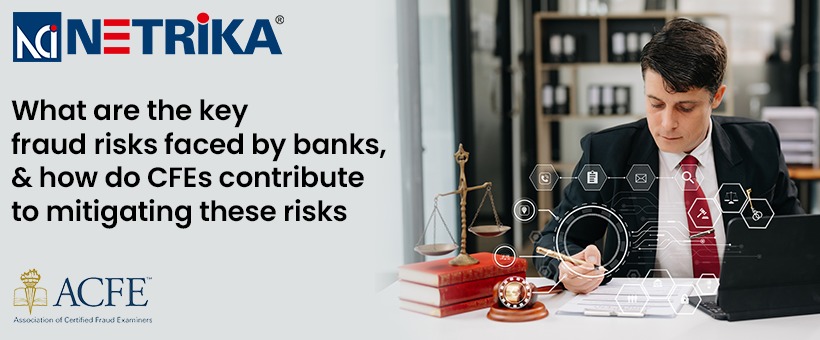News & Events
What are the key fraud risks faced by banks, and how do CFEs contribute to mitigating these risks
- December 28, 2023
- Posted by: marketing@netrika.com
- Category: Blogs

One of the most recurring problems that financial institutions and their clients deal with is banking fraud, which is extremely dangerous for everyone concerned. The Federal Trade Commission states that it received 2.8 million consumer fraud reports in 2021 alone, with $5.8 billion in total fraud losses. Customers aren’t the only ones who pay for fraud: and banks incur $4 in costs for every dollar lost to fraud, and that figure doesn’t even account for the harm fraud may do to a bank’s reputation.
Fraud has increased in tandem with the Internet banking systems, with criminals creating new digital techniques to steal the identities of victims and access their accounts. Given these circumstances, it should come as no surprise that 96% of banking clients believe security and fraud prevention to be either “somewhat” or “very” important when selecting a bank.
To combat fraud in digital environments, banks need to use cutting-edge technology as well as certified CFEs to improve their financial fraud detection and prevention tactics in order to protect the trust of their current clientele and attract new ones.
The fact that banking fraud can take many different forms and that new schemes are created regularly is one of its most annoying aspects. After all, turning around is one of the fraudsters’ specialities. Some of the most prevalent types of fraud risks prevalent in the banking sector include but are not limited to:
Phishing: In a phishing attack, a malicious actor contacts a victim via phone, text, or email by pretending to be their bank. The ultimate goal of scammers is to persuade their victims to enter personally identifiable information or click a link that installs malware, ransomware, or spyware on their machines. Phishing is a type of social engineering that frequently serves as a starting point for various types of banking fraud by giving thieves somewhere to launch follow-up attacks. Phishing is not only quite popular but also very successful since con artists can often imitate reputable organisations with startling accuracy. Furthermore, phishing puts financial institutions themselves at risk in addition to banking clients: Phishing assaults are a primary source of corporate data breaches, and bank personnel are frequently singled out by con artists attempting to obtain access to internal systems.
Identity theft: Arguably the most fundamental type of fraud, identity theft is any criminal activity in which the victim obtains another person’s personally identifying information, e.g., name, phone number, or address and uses it fraudulently. Account takeover attacks occur when thieves utilise a bank customer’s identity that has been stolen to get access to the customer’s online account. Theft of bank client information is known as identity theft, which is another common type of fraud.
Wire Fraud: The use of the internet or telecommunications to deceive people, frequently across state or national lines, is referred to as wire fraud. Scammers in the financial services industry/banks frequently pose as friends or family members in need of immediate financial assistance to deceive banking customers into sending money via wire transfer.
Certified Fraud Examiners (CFEs) are equipped with specialised knowledge and abilities that allow them to identify indicators of fraudulent activity in organisations. CFEs uncover suspicious activity by analysing financial data, gathering evidence, and performing thorough investigations using forensic accounting procedures in banks. Their expertise in data analysis, interviewing techniques, and internal controls enables them to spot fraudulent schemes that could otherwise go undetected. By keeping an eye out for fraud and minimising the financial losses and damage to their reputation, CFEs act as the first line of defence.

